
Haarlem is a city and municipality in the Netherlands. It is the capital of the province of North Holland. Haarlem is situated at the northern edge of the Randstad, one of the more populated metropolitan areas in Europe; it is also part of the Amsterdam metropolitan area. Haarlem had a population of 162,543 in 2021.

Zandvoort is a municipality in the province of North Holland, Netherlands. It is one of the major beach resorts of the Netherlands; it has a long sandy beach. It is bordered by coastal dunes of Zuid-Kennemerland National Park and the Amsterdam water supply dunes. It hosts the country's most prominent motor racing circuit, Circuit Zandvoort. It was named after John Zandvoort, responsible for the construction of the Zandvoort race track.

Hoofddorp is the main town of the municipality of Haarlemmermeer, in the province of North Holland, the Netherlands. In 2021, the population was 77,885. The town was founded in 1853, immediately after the Haarlemmermeer had been drained.
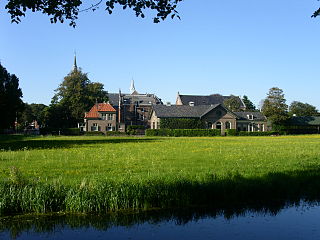
Overveen is a village in North Holland in the Netherlands, in the municipality of Bloemendaal. Overveen lies on the eastern fringe of the North Sea dunes. To the east it borders the built-up areas of Haarlem. A few kilometres to the west of the town lies the Erebegraafplaats Bloemendaal, where many Second World War victims have been reburied, including resistance fighter Hannie Schaft, sculptor and resistance leader Gerrit van der Veen, banker and resistance member Walraven van Hall, Physician and former Wehrmacht officer Karl Gröger, and sculptor and resistance member Johan Limpers. The town is connected to rail service by the Overveen railway station which opened in 1881 on the Haarlem to Zandvoort railway line.
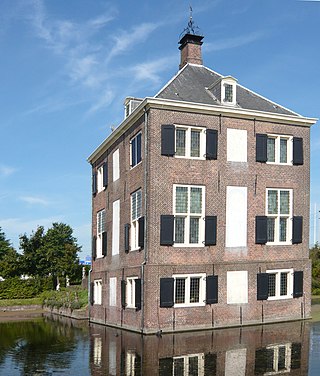
Hofwijck is a mansion built for 17th-century politician Constantijn Huygens. It is located in Voorburg on the Vliet canal from The Hague to Leiden. Formal address of the cultural heritage is 2 Westeinde, Voorburg, the Netherlands, but its location today is better known as the Voorburg railway station.
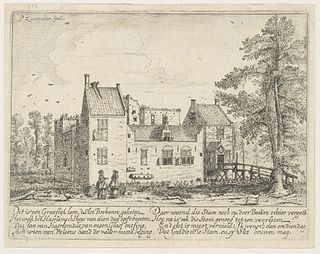
Berkenrode, or Berckenroode is a former 'Heerlijkheid' in the Dutch province of North Holland, situated on the southwest side of Haarlem on the leidsevaart, north of Iepenrode and west of Heemstede. The original castle Berkenrode in the center of the moat was burned by the Spanish during the siege of Haarlem in 1572. The castle was rebuilt and despite suffering another fire in 1747 the settlement continued to function as a separate municipality with its own chapel up to 1857, when the town was annexed by Heemstede. The town archives are now kept at the North Holland Archives in Haarlem.

De Naald is a monument in Heemstede, Netherlands, erected in 1817 by the city council to commemorate two battles on the Manpad road running next to the site. The site is at the corner of the Manpad, and Herenweg, on property belonging to the estate 'Huis te Manpad'.

The Leidsevaart is a canal between the cities of Haarlem and Leiden in the Netherlands. It was dug in 1657, making it one of the oldest canals in the Netherlands. It was the major means of transport between Leiden and Haarlem for almost two centuries until the rail connection was established in the 19th century. The original stops along the railway mirrored the toll bridges of the canal.

The Hollandsche IJzeren Spoorweg-Maatschappij or HSM was the first railway company in the Netherlands founded on 8 August 1837 as a private company, starting operation in 1839 with a line between Amsterdam and Haarlem. The company remained operational until 1938, when it merged with the Maatschappij tot Exploitatie van Staatsspoorwegen (SS) to form the Nederlandse Spoorwegen (NS).

The history of rail transport in the Netherlands is generally considered to have begun on September 20, 1839, when the first train, drawn by De Arend, successfully made the 16 km (9.9 mi) trip from Amsterdam to Haarlem. However, the first plan for a railroad in the Netherlands was launched only shortly after the first railroad opened in Britain.

Leiden Centraal is the main railway station in Leiden, a university city in the Netherlands. In 2019, it was the nation's sixth-most important station in terms of travel numbers, with 82.689 daily passengers. The station is an important transit hub for the c. 35,000 non-resident higher education students studying in the city, as well as for Leiden's surrounding area, including the seaside town of Katwijk.

Den Haag HS, an abbreviation of the original name Den Haag Hollands Spoor, is the oldest train station in The Hague, South Holland, Netherlands, located on the Amsterdam–Haarlem–Rotterdam railway. It is the second main station in The Hague and, unlike The Hague Central Station, it is not a terminus station. The name of the station is derived from the former Hollandsche IJzeren Spoorweg-Maatschappij (HIJSM) which was the first Dutch railway company.

Den Haag Laan van NOI railway station is a railway station in the Netherlands, on the border between The Hague and the town of Voorburg. It is served by the Nederlandse Spoorwegen and by the RandstadRail light-rail network. The station is named after the road on which it is located, Laan van Nieuw Oost-Indië, which literally translates as New East Indies Avenue, but probably refers to a former inn called Nieuw Oosteinde.
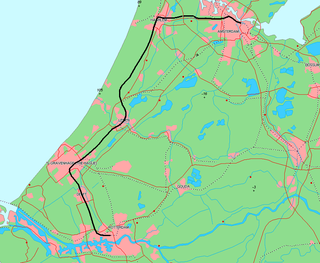
The railway from Amsterdam through Haarlem to Rotterdam runs from Amsterdam Centraal to Rotterdam Centraal through Haarlem.

Vocational School, Vakschool, Huishoudschool, or Ambachtsschool in Haarlem refers to set of Haarlem schools that conformed to a type of Dutch Junior High School based on practical training with the aim of obtaining employment. This type of school was discontinued with the 1968 law for further schooling called the Wet op het voortgezet onderwijs or Mammoetwet.

Beijnes is a defunct Haarlem manufacturer of carriages, buses, trains, and trams. It was closely associated with the Hollandsche IJzeren Spoorweg-Maatschappij (HIJSM)

The Gouda–Den Haag railway is a heavily used railway line in the Netherlands, running from Gouda railway station to Den Haag Centraal railway station, passing through Zoetermeer railway station. It was opened on May 1, 1870.
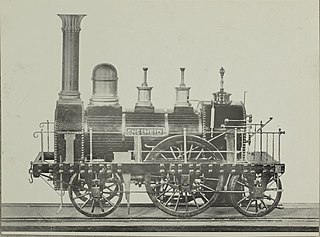
The Snelheid was the name of the first locomotive in the Netherlands, which, together with the De Arend, pulled the first train between Amsterdam and Haarlem.

The NS 7600 was a series of tank engines of the Dutch Railways (NS) and its predecessor Hollandsche IJzeren Spoorweg-Maatschappij (HSM) and Haarlem-Zandvoort Spoorweg Maatschappij (HZSM).

The Haarlem-Zandvoort Spoorweg Maatschappij (HZSM) was the first local railway company in the Netherlands, founded on November 29, 1880, in Amsterdam. This company built the Haarlem - Zandvoort railway, which was opened on June 3, 1881.



















